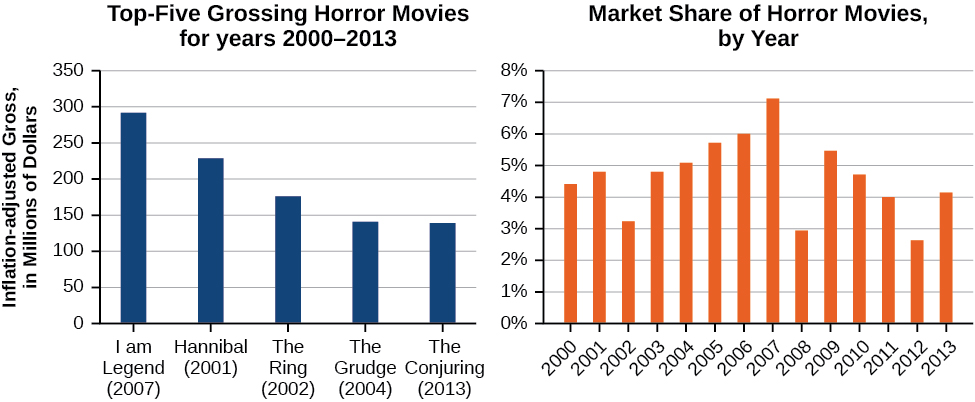
In this section, you will:
If you’re in the mood for a scary movie, you may want to check out one of the five most popular horror movies of all time—I am Legend, Hannibal, The Ring, The Grudge, and The Conjuring. [link] shows the amount, in dollars, each of those movies grossed when they were released as well as the ticket sales for horror movies in general by year. Notice that we can use the data to create a function of the amount each movie earned or the total ticket sales for all horror movies by year. In creating various functions using the data, we can identify different independent and dependent variables, and we can analyze the data and the functions to determine the domain and range. In this section, we will investigate methods for determining the domain and range of functions such as these.

In Functions and Function Notation, we were introduced to the concepts of domain and range. In this section, we will practice determining domains and ranges for specific functions. Keep in mind that, in determining domains and ranges, we need to consider what is physically possible or meaningful in real-world examples, such as tickets sales and year in the horror movie example above. We also need to consider what is mathematically permitted. For example, we cannot include any input value that leads us to take an even root of a negative number if the domain and range consist of real numbers. Or in a function expressed as a formula, we cannot include any input value in the domain that would lead us to divide by 0.
We can visualize the domain as a “holding area” that contains “raw materials” for a “function machine” and the range as another “holding area” for the machine’s products. See [link].
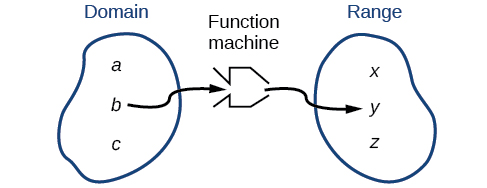
We can write the domain and range in interval notation, which uses values within brackets to describe a set of numbers. In interval notation, we use a square bracket [ when the set includes the endpoint and a parenthesis ( to indicate that the endpoint is either not included or the interval is unbounded. For example, if a person has $100 to spend, he or she would need to express the interval that is more than 0 and less than or equal to 100 and write
We will discuss interval notation in greater detail later.
Let’s turn our attention to finding the domain of a function whose equation is provided. Oftentimes, finding the domain of such functions involves remembering three different forms. First, if the function has no denominator or an even root, consider whether the domain could be all real numbers. Second, if there is a denominator in the function’s equation, exclude values in the domain that force the denominator to be zero. Third, if there is an even root, consider excluding values that would make the radicand negative.
Before we begin, let us review the conventions of interval notation:
See [link] for a summary of interval notation.
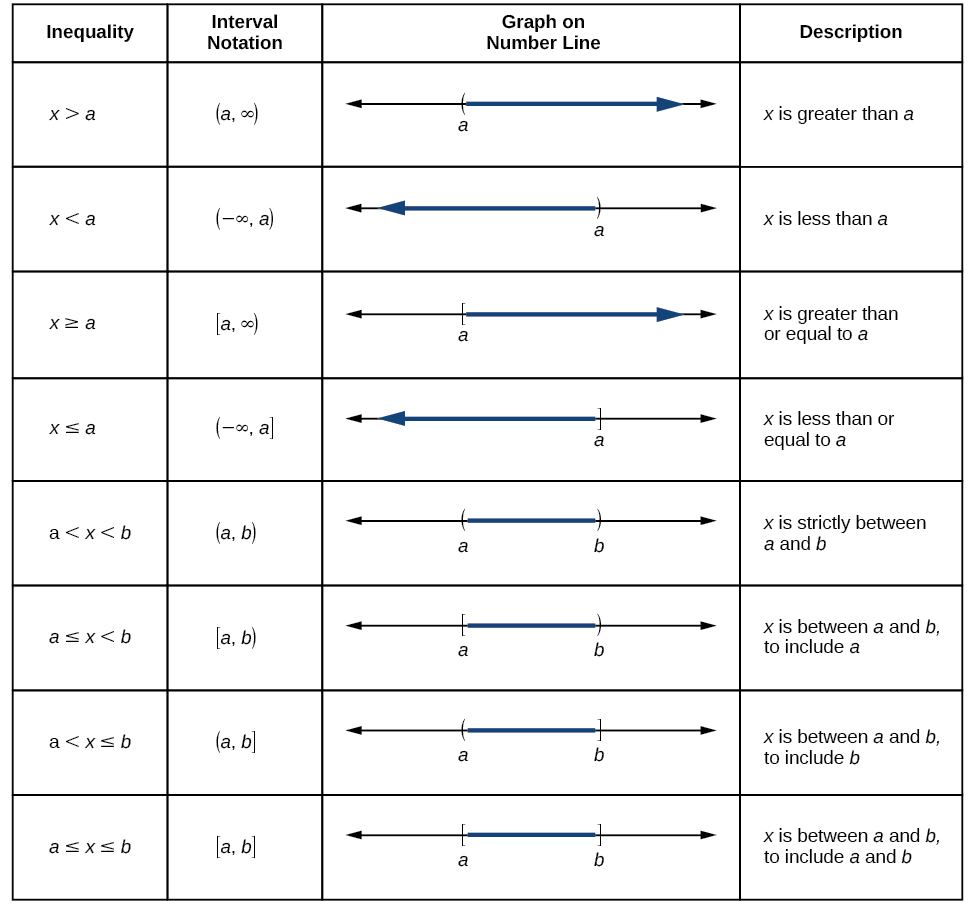
Find the domain of the following function:
.
First identify the input values. The input value is the first coordinate in an ordered pair. There are no restrictions, as the ordered pairs are simply listed. The domain is the set of the first coordinates of the ordered pairs.
Find the domain of the function:
Given a function written in equation form, find the domain.
Find the domain of the function
The input value, shown by the variable
in the equation, is squared and then the result is lowered by one. Any real number may be squared and then be lowered by one, so there are no restrictions on the domain of this function. The domain is the set of real numbers.
In interval form, the domain of
is
Find the domain of the function:
Given a function written in an equation form that includes a fraction, find the domain.
. If the function’s formula contains an even root, set the radicand greater than or equal to 0, and then solve.
Find the domain of the function
When there is a denominator, we want to include only values of the input that do not force the denominator to be zero. So, we will set the denominator equal to 0 and solve for
Now, we will exclude 2 from the domain. The answers are all real numbers where
or
We can use a symbol known as the union,
to combine the two sets. In interval notation, we write the solution:
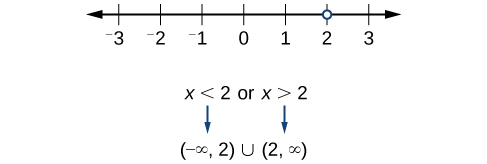
In interval form, the domain of
is
Find the domain of the function:
Given a function written in equation form including an even root, find the domain.
Find the domain of the function
When there is an even root in the formula, we exclude any real numbers that result in a negative number in the radicand.
Set the radicand greater than or equal to zero and solve for
Now, we will exclude any number greater than 7 from the domain. The answers are all real numbers less than or equal to
or
Find the domain of the function
Can there be functions in which the domain and range do not intersect at all?
*Yes. For example, the function
has the set of all positive real numbers as its domain but the set of all negative real numbers as its range. As a more extreme example, a function’s inputs and outputs can be completely different categories (for example, names of weekdays as inputs and numbers as outputs, as on an attendance chart), in such cases the domain and range have no elements in common.*
In the previous examples, we used inequalities and lists to describe the domain of functions. We can also use inequalities, or other statements that might define sets of values or data, to describe the behavior of the variable in set-builder notation. For example,
describes the behavior of
in set-builder notation. The braces
are read as “the set of,” and the vertical bar \| is read as “such that,” so we would read
as “the set of x-values such that 10 is less than or equal to
and
is less than 30.”
[link] compares inequality notation, set-builder notation, and interval notation.
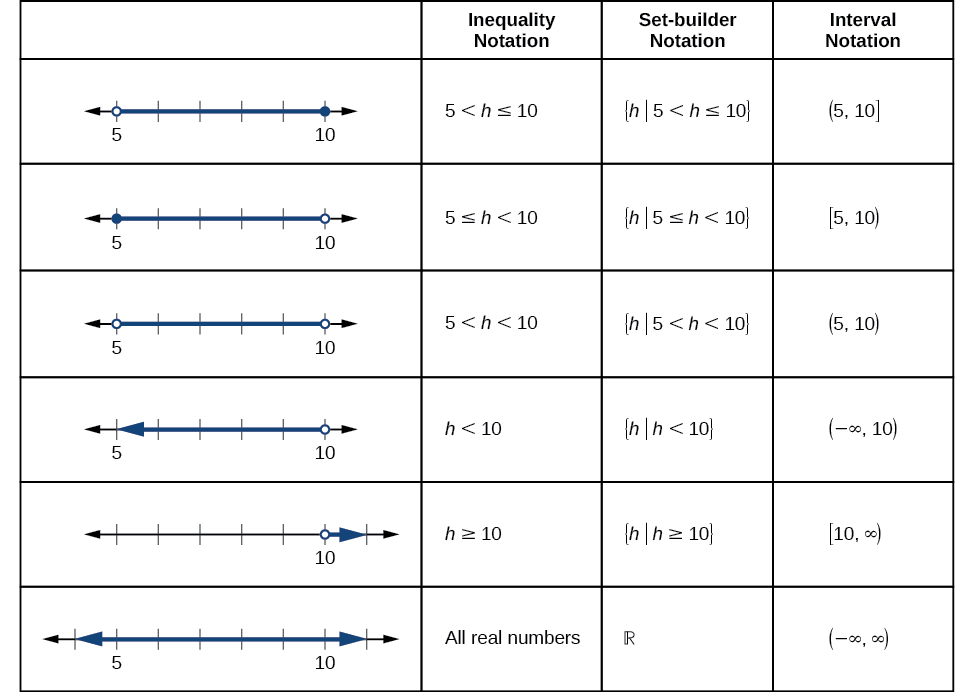
To combine two intervals using inequality notation or set-builder notation, we use the word “or.” As we saw in earlier examples, we use the union symbol,
to combine two unconnected intervals. For example, the union of the sets
and
is the set
It is the set of all elements that belong to one or the other (or both) of the original two sets. For sets with a finite number of elements like these, the elements do not have to be listed in ascending order of numerical value. If the original two sets have some elements in common, those elements should be listed only once in the union set. For sets of real numbers on intervals, another example of a union is
Set-builder notation is a method of specifying a set of elements that satisfy a certain condition. It takes the form
which is read as, “the set of all
such that the statement about
is true.” For example,
Interval notation is a way of describing sets that include all real numbers between a lower limit that may or may not be included and an upper limit that may or may not be included. The endpoint values are listed between brackets or parentheses. A square bracket indicates inclusion in the set, and a parenthesis indicates exclusion from the set. For example,
Given a line graph, describe the set of values using interval notation.
to combine all intervals into one set.
Describe the intervals of values shown in [link] using inequality notation, set-builder notation, and interval notation.

To describe the values,
included in the intervals shown, we would say, “
is a real number greater than or equal to 1 and less than or equal to 3, or a real number greater than 5.”
| Inequality |
| Set-builder notation |
| Interval notation |
Remember that, when writing or reading interval notation, using a square bracket means the boundary is included in the set. Using a parenthesis means the boundary is not included in the set.
;
Another way to identify the domain and range of functions is by using graphs. Because the domain refers to the set of possible input values, the domain of a graph consists of all the input values shown on the x-axis. The range is the set of possible output values, which are shown on the y-axis. Keep in mind that if the graph continues beyond the portion of the graph we can see, the domain and range may be greater than the visible values. See [link].
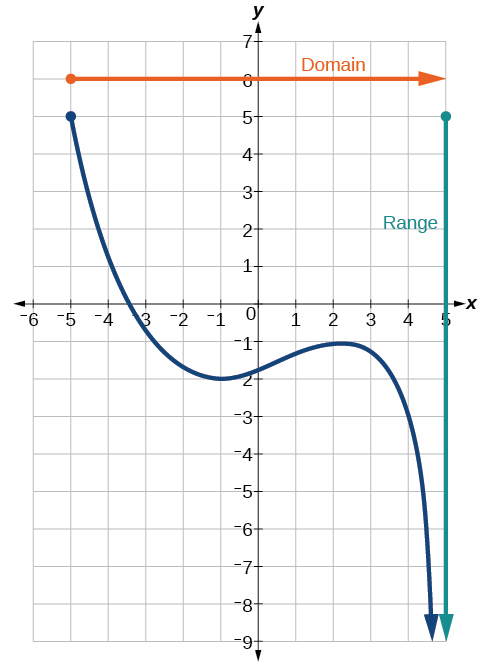
We can observe that the graph extends horizontally from
to the right without bound, so the domain is
The vertical extent of the graph is all range values
and below, so the range is
Note that the domain and range are always written from smaller to larger values, or from left to right for domain, and from the bottom of the graph to the top of the graph for range.
Find the domain and range of the function
whose graph is shown in [link].

The input quantity along the horizontal axis is “years,” which we represent with the variable
for time. The output quantity is “thousands of barrels of oil per day,” which we represent with the variable
for barrels. The graph may continue to the left and right beyond what is viewed, but based on the portion of the graph that is visible, we can determine the domain as
and the range as approximately
In interval notation, the domain is [1973, 2008], and the range is about [180, 2010]. For the domain and the range, we approximate the smallest and largest values since they do not fall exactly on the grid lines.
Given [link], identify the domain and range using interval notation.
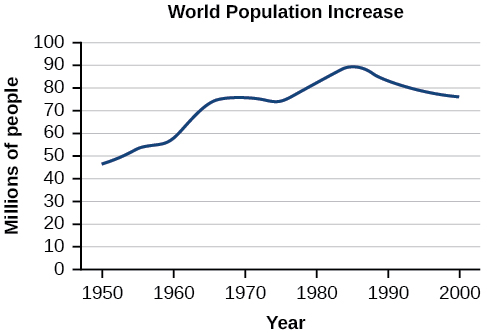
domain =[1950,2002] range = [47,000,000,89,000,000]
Can a function’s domain and range be the same?
Yes. For example, the domain and range of the cube root function are both the set of all real numbers.
We will now return to our set of toolkit functions to determine the domain and range of each.
![For the constant function
f(x)=c,
the domain consists of all real numbers; there are no restrictions on the input. The only output value is the constant
c,
so the range is the set
{c}
that contains this single element. In interval notation, this is written as
[c,c],
the interval that both begins and ends with
c.
Constant function f(x)=c.](../resources/CNX_Precalc_Figure_01_02_011.jpg)
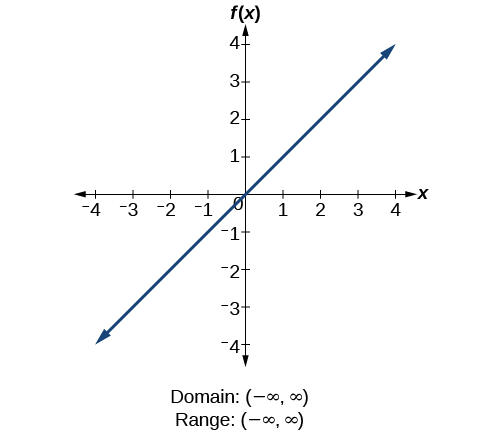
| = | x | , there is no restriction on x. However, because absolute value is defined as a distance from 0, the output can only be greater than or equal to 0.”){: #Figure_01_02_013} |
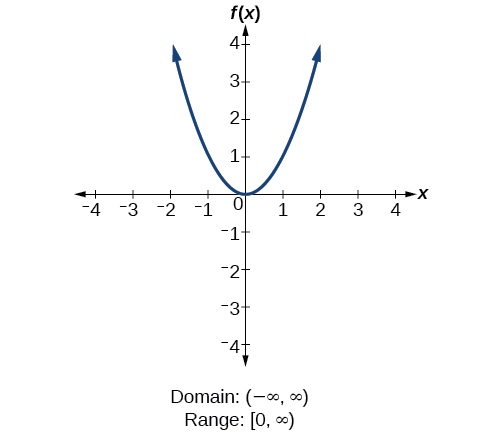
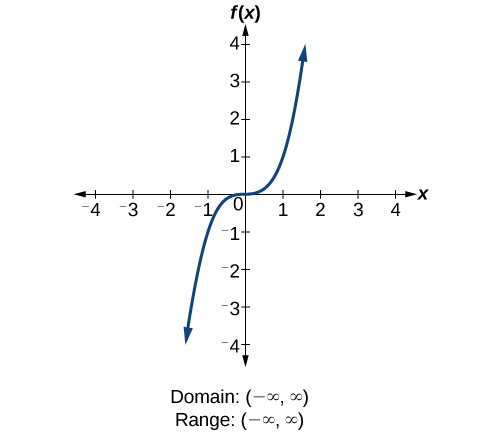
| = 1 x , we cannot divide by 0, so we must exclude 0 from the domain. Further, 1 divided by any value can never be 0, so the range also will not include 0. In set-builder notation, we could also write {x | x≠0}, the set of all real numbers that are not zero.”){: #Figure_01_02_016} |
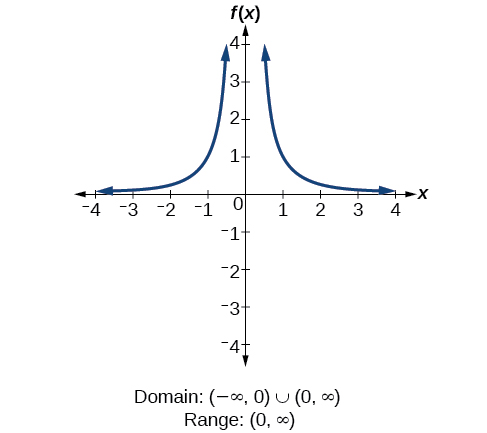
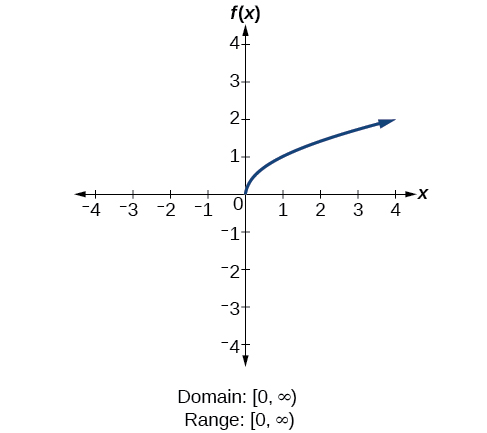
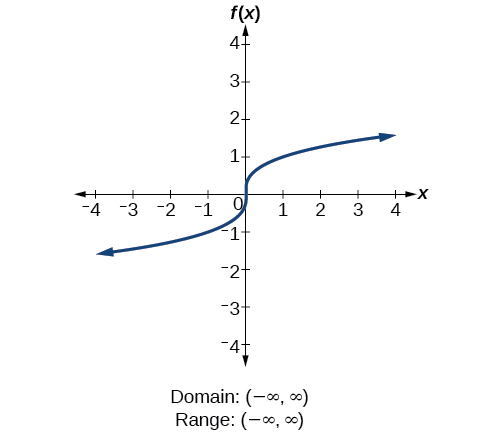
Given the formula for a function, determine the domain and range.
Find the domain and range of
There are no restrictions on the domain, as any real number may be cubed and then subtracted from the result.
The domain is
and the range is also
Find the domain and range of
We cannot evaluate the function at
because division by zero is undefined. The domain is
Because the function is never zero, we exclude 0 from the range. The range is
Find the domain and range of
We cannot take the square root of a negative number, so the value inside the radical must be nonnegative.
The domain of
is
We then find the range. We know that
and the function value increases as
increases without any upper limit. We conclude that the range of
is
Find the domain and range of
domain:
range:
Sometimes, we come across a function that requires more than one formula in order to obtain the given output. For example, in the toolkit functions, we introduced the absolute value function
With a domain of all real numbers and a range of values greater than or equal to 0, absolute value can be defined as the magnitude, or modulus, of a real number value regardless of sign. It is the distance from 0 on the number line. All of these definitions require the output to be greater than or equal to 0.
If we input 0, or a positive value, the output is the same as the input.
If we input a negative value, the output is the opposite of the input.
Because this requires two different processes or pieces, the absolute value function is an example of a piecewise function. A piecewise function is a function in which more than one formula is used to define the output over different pieces of the domain.
We use piecewise functions to describe situations in which a rule or relationship changes as the input value crosses certain “boundaries.” For example, we often encounter situations in business for which the cost per piece of a certain item is discounted once the number ordered exceeds a certain value. Tax brackets are another real-world example of piecewise functions. For example, consider a simple tax system in which incomes up to $10,000 are taxed at 10%, and any additional income is taxed at 20%. The tax on a total income
would be
if
and
if
A piecewise function is a function in which more than one formula is used to define the output. Each formula has its own domain, and the domain of the function is the union of all these smaller domains. We notate this idea like this:
In piecewise notation, the absolute value function is
Given a piecewise function, write the formula and identify the domain for each interval.
A museum charges $5 per person for a guided tour with a group of 1 to 9 people or a fixed $50 fee for a group of 10 or more people. Write a function relating the number of people,
to the cost,
Two different formulas will be needed. For n-values under 10,
For values of
that are 10 or greater,
The function is represented in [link]. The graph is a diagonal line from
to
and a constant after that. In this example, the two formulas agree at the meeting point where
but not all piecewise functions have this property.
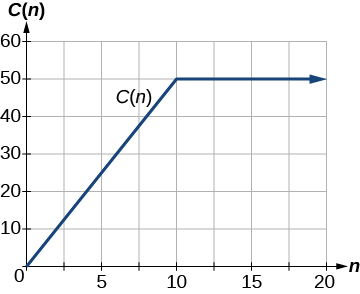
A cell phone company uses the function below to determine the cost,
in dollars for
gigabytes of data transfer.
Find the cost of using 1.5 gigabytes of data and the cost of using 4 gigabytes of data.
To find the cost of using 1.5 gigabytes of data,
we first look to see which part of the domain our input falls in. Because 1.5 is less than 2, we use the first formula.
To find the cost of using 4 gigabytes of data,
we see that our input of 4 is greater than 2, so we use the second formula.
The function is represented in [link]. We can see where the function changes from a constant to a shifted and stretched identity at
We plot the graphs for the different formulas on a common set of axes, making sure each formula is applied on its proper domain.
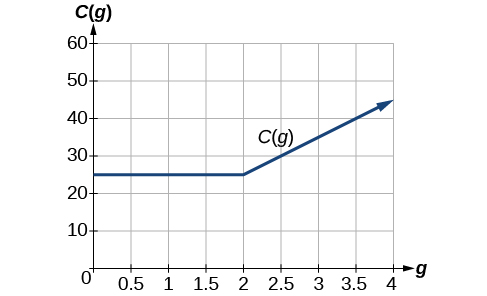
Given a piecewise function, sketch a graph.
Sketch a graph of the function.
Each of the component functions is from our library of toolkit functions, so we know their shapes. We can imagine graphing each function and then limiting the graph to the indicated domain. At the endpoints of the domain, we draw open circles to indicate where the endpoint is not included because of a less-than or greater-than inequality; we draw a closed circle where the endpoint is included because of a less-than-or-equal-to or greater-than-or-equal-to inequality.
[link] shows the three components of the piecewise function graphed on separate coordinate systems.
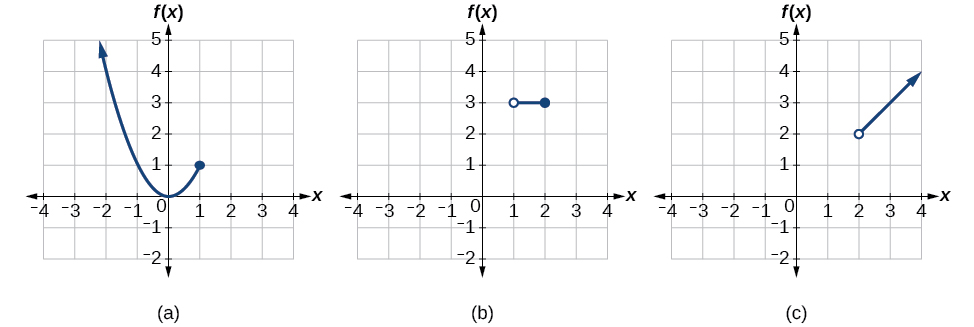
Now that we have sketched each piece individually, we combine them in the same coordinate plane. See [link].
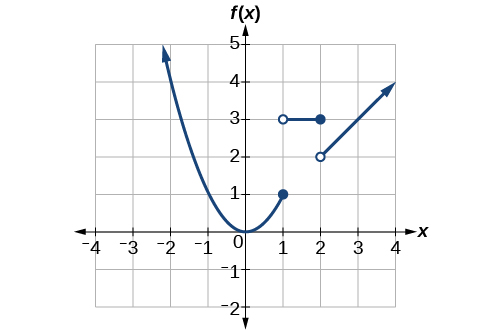
Note that the graph does pass the vertical line test even at
and
because the points
and
are not part of the graph of the function, though
and
are.
Graph the following piecewise function.
Can more than one formula from a piecewise function be applied to a value in the domain?
No. Each value corresponds to one equation in a piecewise formula.
Access these online resources for additional instruction and practice with domain and range.
Why does the domain differ for different functions?
The domain of a function depends upon what values of the independent variable make the function undefined or imaginary.
How do we determine the domain of a function defined by an equation?
Explain why the domain of
is different from the domain of
There is no restriction on
for
because you can take the cube root of any real number. So the domain is all real numbers,
When dealing with the set of real numbers, you cannot take the square root of negative numbers. So
-values are restricted for
to nonnegative numbers and the domain is
When describing sets of numbers using interval notation, when do you use a parenthesis and when do you use a bracket?
How do you graph a piecewise function?
Graph each formula of the piecewise function over its corresponding domain. Use the same scale for the
-axis and
-axis for each graph. Indicate inclusive endpoints with a solid circle and exclusive endpoints with an open circle. Use an arrow to indicate
or
Combine the graphs to find the graph of the piecewise function.
For the following exercises, find the domain of each function using interval notation.
Find the domain of the function
by:
For the following exercises, write the domain and range of each function using interval notation.
domain:
range
domain:
range:
domain:
range:
domain:
range:
domain:
range:
domain:
range:
For the following exercises, sketch a graph of the piecewise function. Write the domain in interval notation.
domain:
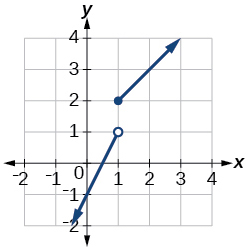
domain:
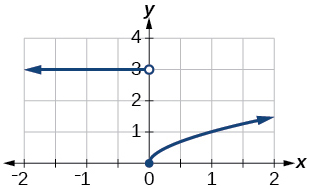
domain:
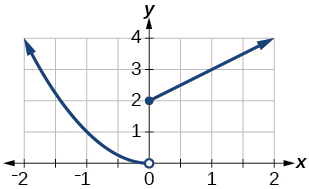
domain:
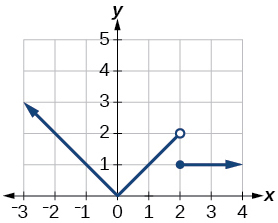
For the following exercises, given each function
evaluate
and
For the following exercises, given each function
evaluate
and
For the following exercises, write the domain for the piecewise function in interval notation.
domain:
Graph
on the viewing window
and
Determine the corresponding range for the viewing window. Show the graphs.
![Graph of the equation from [-0.5, -0.1].](../resources/CNX_Precalc_Figure_01_02_221.jpg) window:
window:
range:
![Graph of the equation from [0.1, 0.5].](../resources/CNX_Precalc_Figure_01_02_222.jpg) window:
window:
range:
Graph
on the viewing window
and
Determine the corresponding range for the viewing window. Show the graphs.
Suppose the range of a function
is
What is the range of
Create a function in which the range is all nonnegative real numbers.
Create a function in which the domain is
Many answers. One function is
The height
of a projectile is a function of the time
it is in the air. The height in feet for
seconds is given by the function
What is the domain of the function? What does the domain mean in the context of the problem?
The domain is
it takes 6 seconds for the projectile to leave the ground and return to the ground
The cost in dollars of making
items is given by the function

You can also download for free at http://cnx.org/contents/fd53eae1-fa23-47c7-bb1b-972349835c3c@8.1
Attribution: